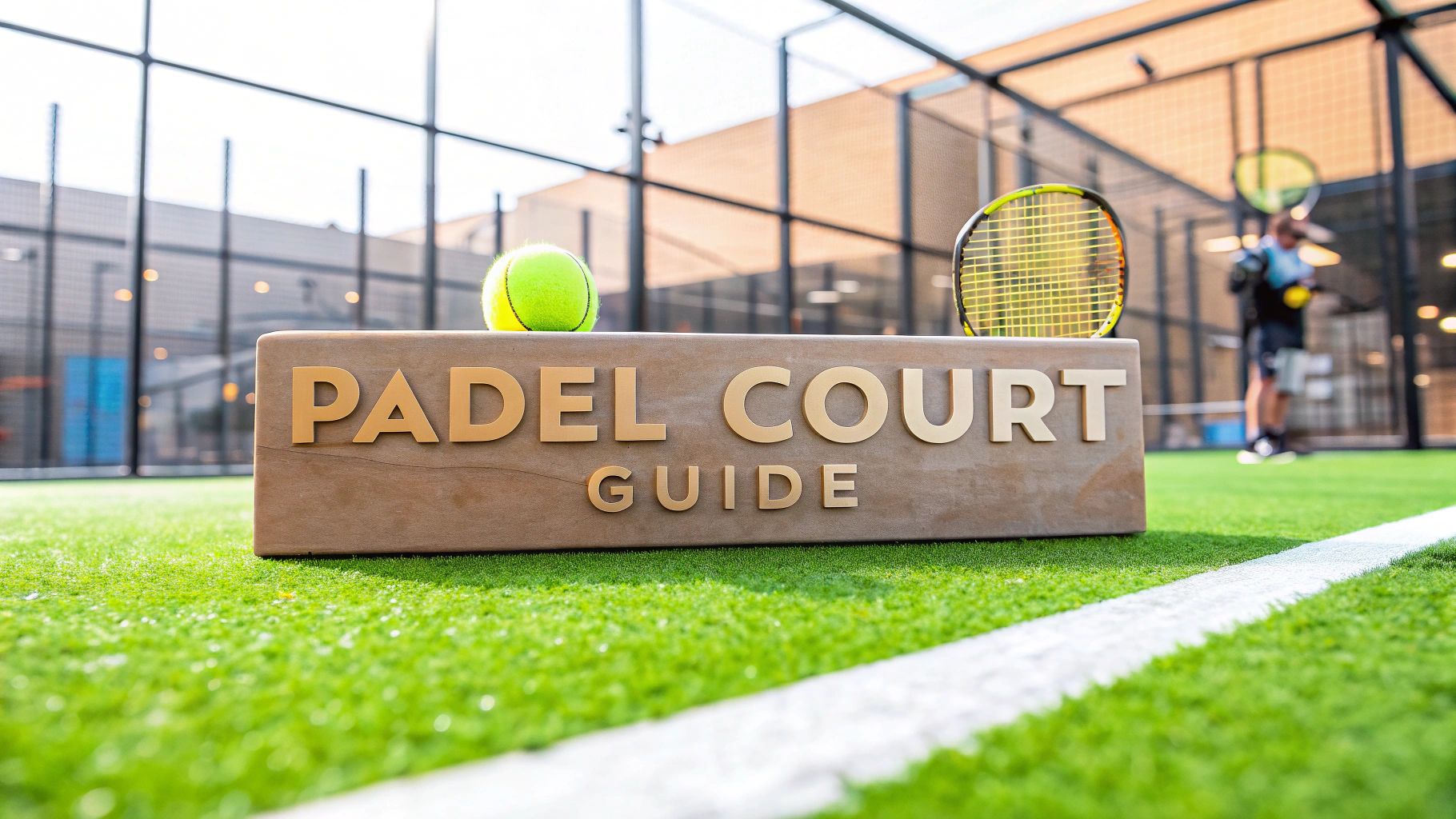Ever wondered what makes a padel court so unique? Imagine taking the familiar net from tennis and dropping it inside a smaller, walled arena, a bit like a squash court. That's the essence of padel. The walls aren't just there to keep the ball in—they're a crucial part of the action, making for a ridiculously fun and fast-paced game.
Your Quick Guide to the Padel Court
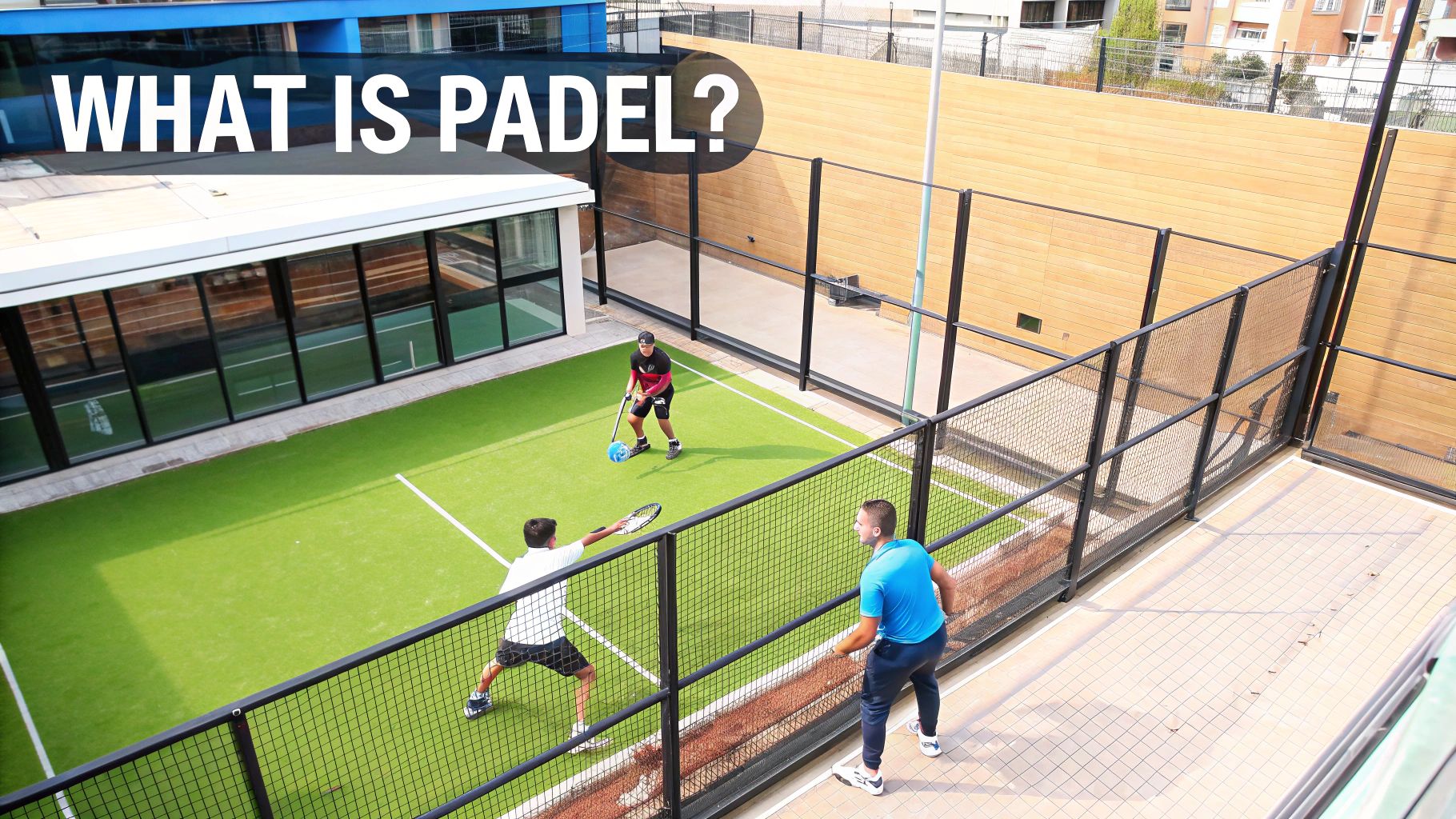
At its heart, a padel court is a purpose-built stage for a one-of-a-kind racket sport. It's not like the wide-open, sprawling space you see in tennis. Instead, a padel court is much more intimate and contained, and this design completely transforms the way the game is played.
This smaller footprint brings players closer together, creating a much more social vibe. But don't let that fool you—it also demands lightning-fast reflexes over the raw power often celebrated in tennis. This setup makes padel incredibly welcoming for newcomers while still offering a deep well of strategy for seasoned players to explore.

Buy the best padel gear to level up your next game!
CHECK OUT this deal from Padel Market!Get ready to take your game to the next level with the latest padel gear from Padel Market! Fast EU and Worldwide Shipping
Core Features and Dimensions
Padel courts aren't just thrown together; they're built to very specific, standardized dimensions that are key to the sport's dynamics. A regulation court is exactly 20 meters long and 10 meters wide, completely enclosed by walls.
The back and side walls, which stand between 3 and 4 meters tall, are usually made of tempered glass. This gives spectators a great view while providing a predictable bounce. Above the glass, a 1-meter high metallic fence helps keep the ball in play during high lobs.
Size-wise, the playing surface is roughly two-thirds smaller than a traditional tennis court. This means less ground to cover but puts a huge emphasis on quick reactions and smart positioning. It's this enclosed design, allowing the ball to be played off the walls, that gives the game its tactical depth.
The key takeaway is this: the court isn't just a playing surface; it's an active part of the game. Those walls aren't boundaries—they're strategic tools you can use for both attack and defense.
To really get good, you need to think beyond just hitting the ball over the net. You have to learn how to use your environment. For a closer look at the rules and strategies that shape the sport, check out our complete guide to the padel game.
Padel Court At a Glance
To put it all together, here's a quick summary of what makes up a standard padel court. Think of this as your cheat sheet for understanding the battlefield.
| Component | Specification | Purpose in the Game |
|---|---|---|
| Dimensions | 20m x 10m | Creates a fast-paced, reflex-based game ideal for doubles play. |
| Enclosure | Glass & Mesh Walls | Allows players to use wall rebounds for strategic shots. |
| Net Height | 0.88m (center) | Encourages more volleys and close-to-the-net action. |
| Surface | Artificial Turf | Provides optimal grip and slide for quick, agile movements. |
As you can see, every element is designed to contribute to padel's unique character—a sport that's as much about clever angles and teamwork as it is about power.
The Accidental Invention of the Padel Court
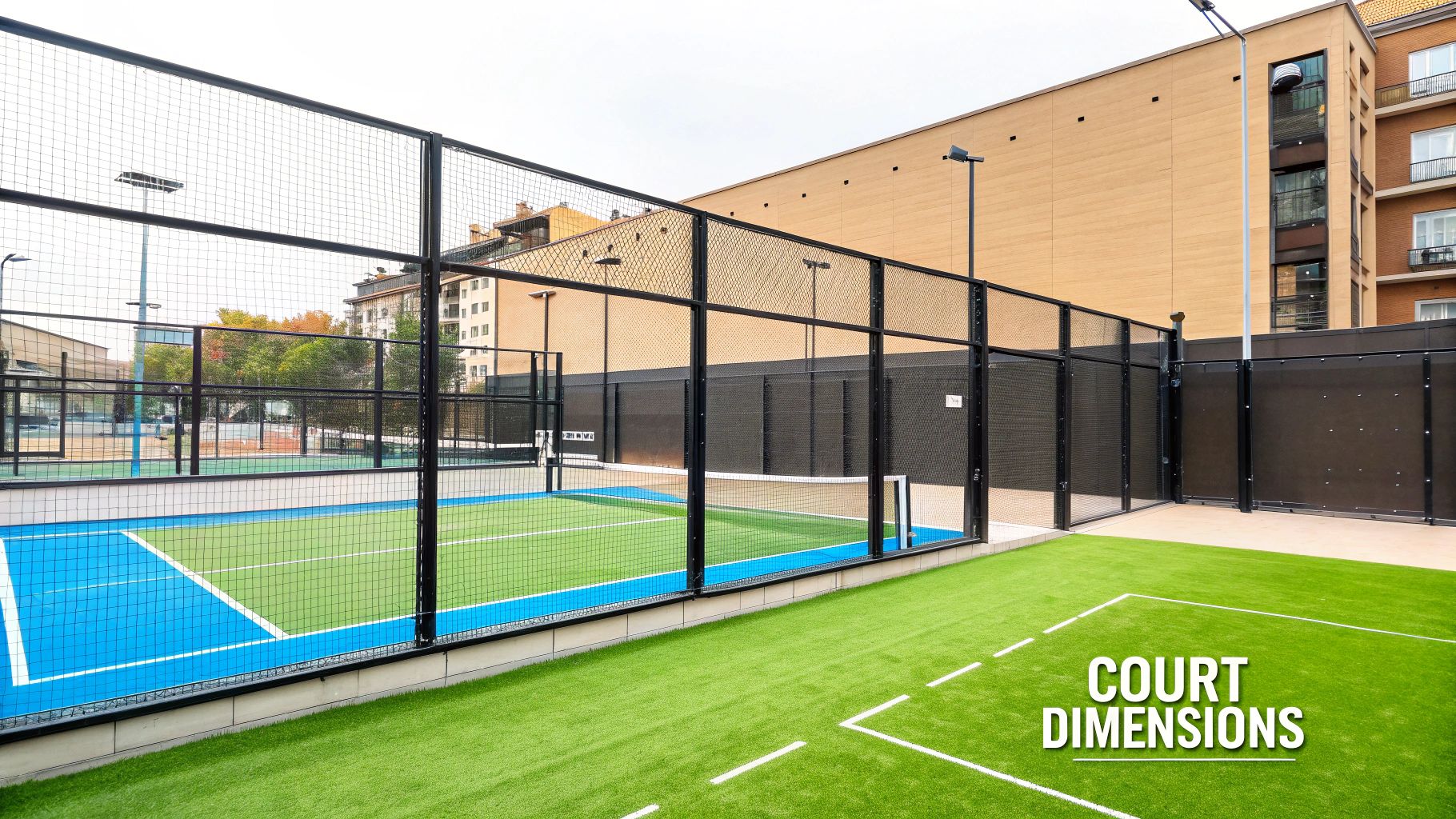
Some of the best inventions happen completely by accident, and the padel court is a perfect example. Its origin story doesn't start in some high-tech sports laboratory but in the backyard of a businessman who was just fed up with chasing after stray tennis balls. This happy accident created the foundation for one of the fastest-growing sports on the planet.
It all goes back to 1969 in Acapulco, Mexico. An avid tennis player named Enrique Corcuera had a frustrating, all-too-common problem: his home tennis court was built right up against his neighbor's property. Every time a powerful shot went wide or a return went long, the ball would fly over the fence, halting the game and probably putting a strain on neighborly relations.
A Practical Fix Ignites a New Sport
Tired of the constant interruptions, Corcuera decided to build walls around his court. His goal was purely practical—keep the ball in play. He wasn't trying to invent a new game; he just wanted to solve a problem by enclosing his smaller, tennis-like court. But once the walls were up, he and his guests started to experiment.
They quickly discovered that allowing the ball to bounce off the walls before hitting it back added an entirely new layer of strategy and excitement. It was like someone had mashed up tennis with the fast, wall-bouncing chaos of squash. Suddenly, the game wasn't just about power; it was about clever angles, quick thinking, and lightning-fast reflexes. A simple, homemade fix had accidentally given birth to a brand-new sport.
This is the real origin of the padel court. Corcuera adapted his space by putting up walls and a metal fence, reaching up to four meters high, around a court that was roughly a third the size of a standard tennis court. This unique setup, originally called “Paddle Corcuera,” made the game more accessible and social. If you want to dive deeper into its roots, you can find more details on the history of padel.
From Backyard Fix to Global Phenomenon: What started as a simple solution for a stray ball problem became the blueprint for every single padel court in the world. Those walls, once just a barrier, became the game's most defining and exciting feature.
This humble beginning is the key to understanding what a padel court is. It’s not just a shrunken-down tennis court; it's an arena purpose-built for rebound play. Corcuera’s accidental invention shows how solving a simple problem can lead to a brilliant new form of recreation that has since hooked millions of players worldwide.
Anatomy of a Padel Court
To really get what a padel court is all about, you have to look past its basic size and see how all the pieces fit together. It’s like a finely tuned machine, purpose-built for fast-paced, strategic action. Every single material and measurement has been deliberately chosen to create the dynamic, rebound-heavy game that defines padel.

Buy the best padel gear to level up your next game!
CHECK OUT this deal from Padel Market!Get ready to take your game to the next level with the latest padel gear from Padel Market! Fast EU and Worldwide Shipping
The official dimensions for a padel court are 20 meters long by 10 meters wide. This isn't just a random size; it's the secret sauce that makes the game flow so well. This compact space keeps all four players close enough for rapid-fire volleys and constant chat, making it as much a social game as a physical one. Unlike the huge, sprawling area of a tennis court, this smaller footprint rewards quick reflexes and smart placement over brute strength.
Walls: The Heart of the Game
The most obvious feature of a padel court is its enclosure, which essentially turns the entire area into a 3D playing field. The walls aren't just there to keep the ball in—they are an active part of every single rally.
- Tempered Glass Panels: The back walls and parts of the side walls are usually made of 10-12 mm thick tempered glass. This is the gold standard because it gives you a true, consistent bounce, letting players confidently predict and use rebounds. Of course, the fact that it's transparent is a huge bonus for anyone watching.
- Metallic Mesh Fencing: The rest of the court is enclosed with a tough metallic mesh. This material is a game-changer because it produces a much more irregular and unpredictable bounce. A ball that hits the mesh will often die down quickly, forcing you to react completely differently than you would to a clean rebound off the glass.
The Playing Surface and Net
What’s under your feet plays a huge part, too. Most modern courts use high-quality artificial turf, which is often lightly sprinkled with sand. This surface gives you the perfect mix of grip for those explosive movements and just enough slide to help you reach tough shots, all while being way easier on your joints than a hard court.
Finally, you’ll notice the net is lower than in tennis, standing at just 0.88 meters high in the center. This small difference makes a big impact, encouraging players to get up close and personal with the net, leading to more aggressive volleys and powerful smashes.
This image really drives home the key size differences between a padel court and its more famous cousin, the tennis court.
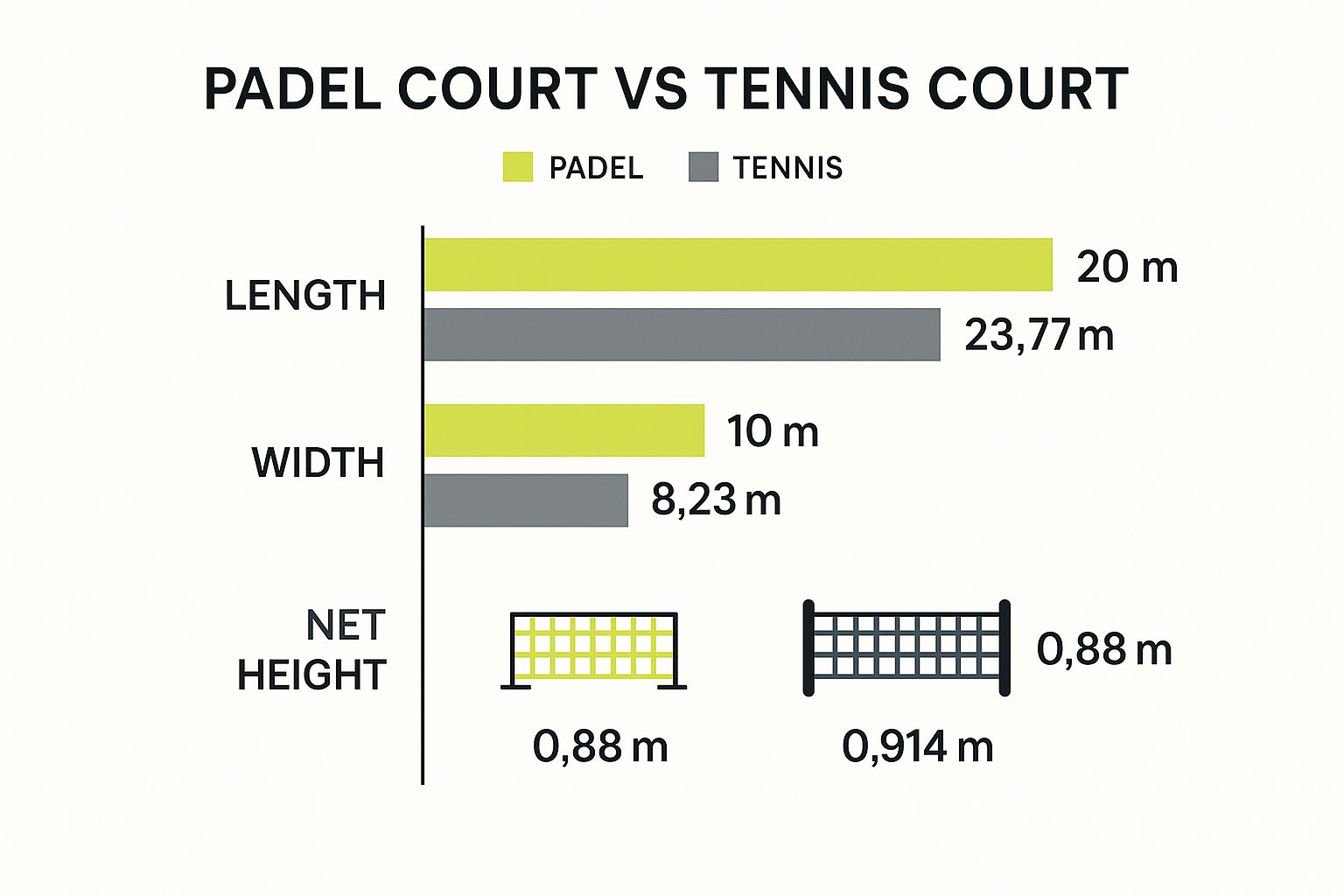
As you can see, the court’s compact dimensions completely change how the game is played. It's a whole different ball game, literally. To get a clearer picture, let's look at them side-by-side.
Padel Court vs Tennis Court Head-to-Head
This table breaks down the fundamental differences between the two courts.
| Feature | Padel Court | Tennis Court |
|---|---|---|
| Dimensions | 20m x 10m (doubles) | 23.77m x 10.97m (doubles) |
| Enclosure | Fully enclosed with glass and mesh walls | Open court with no walls in play |
| Walls in Play? | Yes, an integral part of the game | No, hitting a fence or wall is a fault |
| Net Height | 0.88m at the center | 0.914m at the center |
| Playing Surface | Typically artificial turf with sand | Grass, clay, or hard court |
| Serve Style | Underhand, after one bounce | Overhand or underhand |
Seeing the specs laid out like this makes it obvious that padel isn't just a smaller version of tennis. It's a unique sport designed from the ground up around its specific court.
In essence, every single element—from the exact height of the glass to the texture of the turf—is engineered to work together perfectly. The result is a contained, strategic battlefield where clever angles, crafty rebounds, and solid teamwork are what bring home the win.
How to Use the Walls to Win
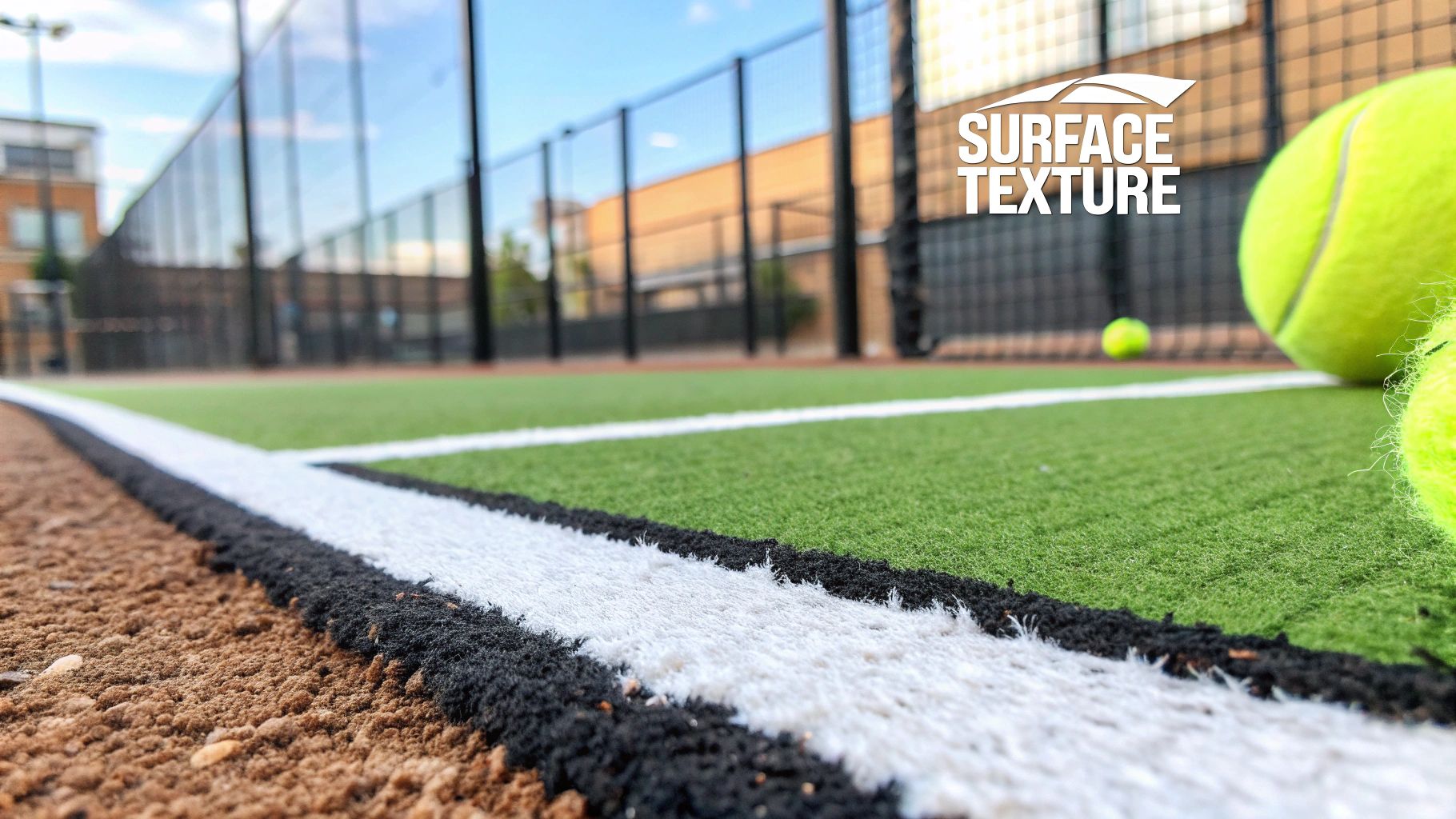
When you first step onto a padel court, the walls probably just look like boundaries. But for any player who knows their stuff, those glass and mesh panels are the most powerful strategic tool in the entire game. Honestly, learning to use the enclosure is what separates a beginner from a seasoned player. It transforms the court from a simple, flat rectangle into a three-dimensional chessboard.
Instead of trying to hit every single shot directly over the net, experienced players will often let a fast ball go right past them. They'll let it hit the back wall and then play the rebound. This one simple move buys them a precious second or two, letting them reset their position and turn a frantic defensive scramble into a calm, controlled, and offensive play. It's a huge mental shift—the back wall isn't an obstacle; it's your best friend.
Reading the Rebounds
Mastering the walls all starts with learning to predict what the ball is going to do. The two main surfaces, glass and mesh, give you completely different results.
- Glass Walls: The tempered glass gives you a clean, true, and predictable bounce. A ball coming off the glass will rebound cleanly, keeping most of its speed and giving you a reliable ball to hit. This is where you can confidently set up your shots.
- Metallic Mesh: The wire fence, on the other hand, is the great disruptor. A ball hitting the mesh will lose nearly all its momentum. It often just dies right there, creating a short, awkward bounce that's tough to handle. This unpredictability makes it a fantastic defensive weapon for neutralizing a hard smash from your opponent.
The real secret to wall play is anticipation. If you watch your opponent's shot and understand how the court's surfaces work, you can get yourself into position for the rebound long before the ball even gets there. That's a massive tactical advantage.
Turning Defense into Attack
Once you can read the bounce, you can start using it to really mess with your opponents. A classic and incredibly effective technique is the "double-wall" shot. This is when the ball hits a side wall, then the back wall, before you return it.
This kind of complex rebound is a nightmare for opponents to read and can totally throw off the rhythm of a point. Imagine a hard-hit ball comes into your corner. You can just let it rebound off the side glass and then the back glass. This gives you plenty of time to step in and play a soft, angled drop shot that your opponents, who have charged the net to attack, have no chance of reaching.
This is the real magic of what a padel court is. It's an arena where you can absorb your opponent's power and use the court’s own geometry to send it back in a way they never see coming. Getting this skill down will fundamentally change how you play every single point.
Getting the Right Gear for the Game
Okay, so you've got the court layout down. That's step one. But showing up with the right equipment is just as crucial if you want to have a great game. While some of the gear might look a little familiar, padel equipment is built from the ground up for the unique dynamics of playing inside an enclosed court. The racket is the most obvious difference.
Forget everything you know about traditional stringed tennis rackets. A padel racket is a solid, stringless piece of kit, typically made from carbon fiber or fiberglass. You'll notice its face is full of holes, which are there to cut down on air resistance and make it easier to whip around for the quick volleys that happen right up at the net. This solid design gives you incredible control over the ball—something you'll be thankful for when you're trying to play clever shots off those glass walls.
The Right Ball and Shoes
The special equipment doesn't stop with the racket. The ball you use is another key piece of the puzzle, specifically designed to work with the smaller court and constant wall play.
- Padel Balls: At a glance, they look just like tennis balls. But they actually have a slightly lower internal pressure. This small tweak means they don't bounce quite as high and travel a bit slower, which gives everyone more time to react and set up their next shot.
- Padel Shoes: The court's artificial turf, which is usually dusted with fine sand, requires a specific kind of shoe. You'll want padel-specific shoes or even clay-court tennis shoes that feature a herringbone sole pattern. This design gives you the perfect mix of grip for those explosive forward movements and just enough slide to reach those tough, wide shots without twisting an ankle.
The big idea behind all padel gear is control over raw power. The slower ball and the solid racket are both designed to encourage longer, more strategic rallies instead of just overpowering your opponent with huge serves and smashes.
Picking the right gear seriously impacts how well you play and, more importantly, how much fun you have. If you're ready to really get into the details, you can learn more about the tech and different options in our ultimate padel racket guide. Having the proper racket, balls, and shoes means you can step onto the court with confidence, ready for whatever comes your way.
Finding and Booking a Padel Court
Alright, so you understand the court's layout and what makes it tick. But let's be honest, the real fun starts when you actually step onto one. The good news? Padel’s popularity has absolutely exploded, which means finding and booking a court is easier than ever. You definitely don’t need to be a member of some exclusive club to get in on the action anymore.
The simplest way to get started is by using a dedicated booking app. Playtomic is the big one—it's pretty much a global hub connecting you to thousands of courts. In just a few taps, you can see what’s available at clubs near you, check out prices, and lock in your time slot on the spot. Of course, many local clubs also have their own straightforward booking systems right on their websites.
What to Look For When Booking
Before you hit that "confirm" button, it pays to check a few practical details. These little things can genuinely make or break your playing experience.
- Peak vs. Off-Peak Pricing: Court prices almost always change depending on how busy the club is. You can save a good chunk of change by booking during off-peak hours, which is usually on weekdays before 5 PM.
- Equipment Rentals: Don't have your own racket or balls yet? No problem. See if the club offers rentals. Most of them do, which is perfect for beginners who want to try the sport before committing to buying their own gear.
- Club Etiquette: Every club has its own unique vibe and set of rules. It’s always a good idea to quickly read any posted info about proper footwear, on-court conduct, or guest policies to make sure your visit goes smoothly.
The social side of padel is a massive part of its appeal. A lot of apps, including Playtomic, let you join public matches if you don't have a full group of four. This is an awesome way to meet other players and find a game whenever you feel like it.
Connecting with the Padel Community
Beyond just booking a court, these platforms are your ticket into the local padel scene. You can use them to sign up for club leagues, find a coach for a few lessons, or join community groups to link up with players at your skill level.
The sport is growing like crazy everywhere, from its heartland in Europe to booming scenes in the Middle East. The sheer speed of new facilities popping up is remarkable. For a closer look at a thriving scene, check out our guide on finding a padel court in Dubai. All it takes is booking that first court to become part of this exciting global community.
Of course. Here is the rewritten section, adopting the natural, expert tone from the provided examples.
Common Questions About Padel Courts
Once you get the hang of what a padel court is all about, a few questions always seem to come up. It's totally normal. Getting these details straight is the best way to really understand what makes padel so unique. Let's clear up some of the most common points of confusion.
Is a Padel Court the Same as a Paddle Tennis Court?
This is a classic mix-up, but the answer is a firm no. They are completely different sports with courts built to match.
Even though the names are similar, a paddle tennis court is smaller than a padel court and is usually enclosed with simple wire screens. Padel, on the other hand, uses those signature glass and mesh walls. Everything from the rules and the rackets to the pressure of the ball is different, which is why padel has its own international federation and is a sport in its own right.
Can You Play Singles on a Standard Padel Court?
Padel is designed from the ground up as a doubles game (two vs. two), and that's how you'll almost always see it played. But for practice or just a casual hit, you can absolutely play singles.
Just be ready for a serious workout! Covering the court's full 10-meter width by yourself is tough and forces a completely different style of play. Some newer, forward-thinking clubs are starting to build dedicated singles courts (20m x 6m), but the overwhelming majority of courts you'll find are made for doubles.
The Bottom Line: You can play singles for fun, but the real heart of padel—its strategy and social vibe—truly comes alive in the doubles format it was created for.
How Much Does It Cost to Build a Padel Court?
The price tag for a padel court can swing wildly depending on the location, choice of materials, and whether you're building indoors or out.
As a ballpark figure, a basic outdoor court will generally run you somewhere between $20,000 and $40,000. This usually covers the essentials: the foundation, tempered glass walls, mesh fencing, artificial turf, and lights. If you start adding premium features like panoramic glass, a higher-grade turf, or need significant groundwork, that price can climb quickly.
What Kind of Shoes Should You Wear on a Padel Court?
This is a fantastic question, and getting it right is crucial for your performance and avoiding injury. You really want to wear either padel-specific shoes or a good pair of clay-court tennis shoes.
Most padel courts have an artificial turf surface with a thin layer of sand on top, which helps with movement. The best shoes for this surface have one of two sole patterns:
- Herringbone: This classic zig-zag design gives you the perfect blend of grip for explosive movements and just enough slide to help you reach those wide shots without twisting an ankle.
- Omni-Court: A sole with a dotted or dimpled pattern also provides fantastic traction on sandy turf, giving you a secure footing while still letting you pivot smoothly.
Ready to dive deeper into the world of padel? At Padel Rumors, we've got you covered with the latest news, in-depth gear reviews, and guides to improve your game. Whether you're a beginner or a pro, find everything you need to know about the sport at https://www.padelrumors.com.





